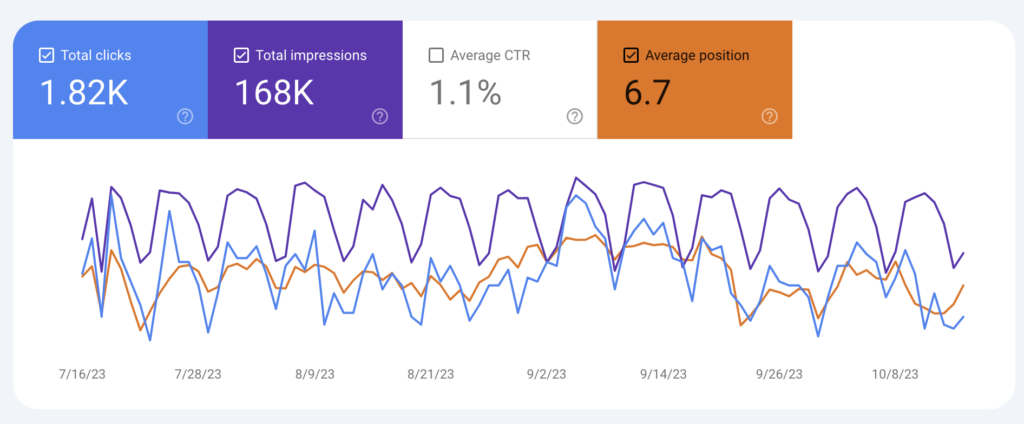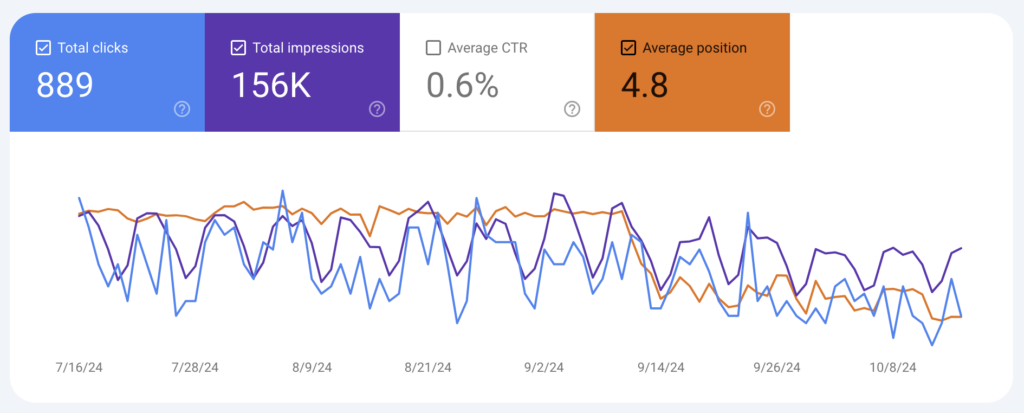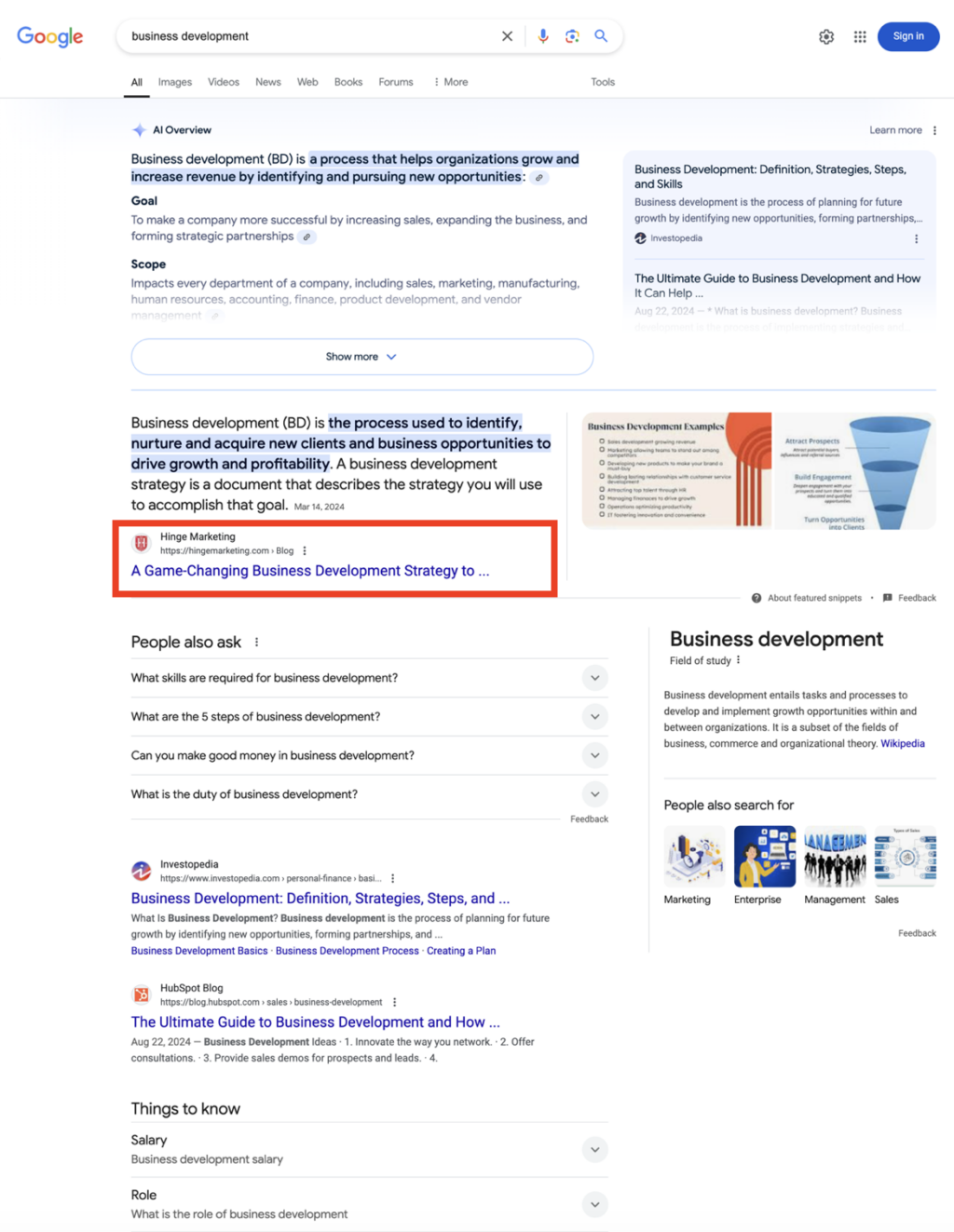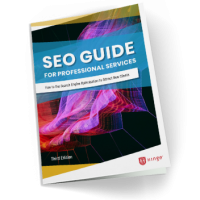We all have “high, high hopes” for our marketing efforts, but is it time to panic?
Since my early days of learning about search engine optimization (SEO), I’ve encountered articles and dramatic LinkedIn posts proclaiming that “SEO is dead” and that it’s a waste of time. However these attention-seeking posts never aligned with the successes we and our clients were having.
Even through major algorithm shifts, SEO played an important role in building visibility and engagement for our marketing and website clients. Of course, we’ve evolved our techniques over time, and like many other respectable experts in the space, we continue to see meaningful results from our emphasis on SEO.
However, the amount of change this year has been different. In May of this year, Google introduced AI Overviews to its search results pages, and everything began to change. Even top SEO experts are sounding alarm bells about how this will negatively impact website traffic, with dramatic results. Gartner predicts that all organic website traffic will decline by 50% by the year 2028. We suspect this number could be even higher.
So what does this mean for professional services firms and how should we adapt? Let’s explore the problem and propose some solutions.
Google’s Greediness, AI Overviews, and More
In Hinge’s research on professional services buyer behavior, we have seen a decade-long trend of buyers increasingly relying on search engines to solve their business problems. These searches would yield a curated list of websites that address the search query. The content deemed most relevant and authoritative would earn a spot at the top of the list. But now Google’s artificial intelligence system is stepping in and wants to provide answers, too.
This year Google introduced the AI Overviews feature (other search platforms have similar technologies). How does it work? For many online search terms, Google serves up a detailed AI-generated summary that addresses a person’s search query. Each answer is sourced from a variety of sources across the web. You may not see this kind of summary for every search right now—and currently there are device and browser restrictions—but we expect this kind of AI-generated content to only become more prevalent.
To illustrate how this tool works and how it could be a threat to your website traffic, let me provide you with a real example from Hinge’s own website performance. And you can test this yourself!
Go to Google’s search engine and search for “business development.” A blog post we wrote currently appears as a well-positioned organic result. We’ve been pretty happy with that, but…
In the last three months we’ve received 889 clicks to the article from this search query. Not bad. But one year ago, during the same date range, we had 1,815 clicks. This is a staggering decline. And this loss in clicks is despite improving our post’s average position from 6.7 to 4.8.
See the stats from Google Search Console for yourself below:
Date range in 2023:

Date range in 2024:

So why has there been such a massive decline in organic search traffic? If you look closely at the numbers you can see that total impressions haven’t gone down significantly. The major change is what Google is putting on the search engine results page (SERP). Take a look at my screen capture below as to where our post lives on the SERP.

This SERP is absolutely packed to the brim with content. There is an AI Overview, featured images, highlighted definitions, a section of things people also ask, and more. All these pieces of content are diluting a user’s attention. And this particular search doesn’t even include sponsored ads!
While traditional search results still appear further down the page, many people will simply stop at the AI Overview. And because many questions can be answered by this summary, no clicking through to a webpage is required. Fewer clicks mean fewer visitors to the websites that show up in those traditional search results.
How does this help Google? Well, they know that the longer they can keep users’ attention within the search portal, the more likely it is that a user will return to use them and eventually click a sponsored ad. Clicks on sponsored ads make them money. And we’ve observed an increase in sponsored ads recently as well. It is another way that Google is making it more difficult for traffic to make it to your website.
Ready for More Disruption? Let’s Talk ChatGPT.
Google’s changes to SERPs is not the only disruption underway right now. Users are increasingly using generative AI tools like ChatGPT instead of search engines. These powerful platforms have created an all-new way for your prospects to find answers to their business problems. The real question now is if your business will appear in those results.
These are still early days for this technology. But we’ve noticed that these platforms are increasingly becoming their own sources of website traffic.
In Q2 of this year, we had 269 sessions come to Hinge’s website from generative AI tools (led mostly by perplexity.ai). This number increased by nearly 100% to 533 sessions in Q3 as ChatGPT and Google Gemini registered their first sessions. And aside from these website sessions, we’ve had multiple qualified business opportunities tell us that ChatGPT is how they found us.
That’s right, business prospects found us by asking ChatGPT. It’s a brave new world.
This is a topic we will continue to explore, but from what we can tell most of the same principles that work well for traditional SEO also work well for being found in these tools. Focusing on the right keywords, publishing long-form, high-quality content, and keeping your content updated all send positive signals to these complex systems that your website is a reputable source of information.
5 Ways to Respond to the Disruption
So with all this disruption underway, what do we do now? Is it time to panic at the SEO disco? Not quite. Here’s how we’re advising our clients to proceed.
1. Double-Down on Your SEO Best Practices
Let me say this as clearly as possible… SEO still matters. A lot.
Is the environment more challenging and competitive than in previous years? Of course. But what’s the alternative here? To stop caring about SEO and website visibility? That would be a mistake.
If you’re unsure that your website is optimized for search engines, or you’re producing thought leadership content without any thought to keywords or search intent, then you’re leaving better results on the table.
Years of data from our annual High Growth Study have shown that the fastest growing professional services firms are more likely to include SEO as a part of their marketing strategy than their slower growing peers. So it’s vital to stay up to date with the latest SEO tactics and to work with specialists who can steer you toward more visibility.
Recommendation: Audit your SEO performance and make improvements. What queries are users searching to find your website? Do you have any pages that are close to ranking in Google’s top 10 search results? If so, how can you improve them to bump them to top positions? Are there opportunities with local or regional SEO to explore? To get the most out of your website and content, work with an experienced specialist—one who can dive deep into your SEO analytics and find real solutions.
2. Increase the Relevance of Your Thought Leadership Content and Business Development Materials
AI-powered tools are making it easier than ever to generate content, leading to an explosion of generic, low-quality content. To stand out in this noisy digital landscape, professional services marketers must prioritize better quality content—content that has a strong point of view or opinion backed up by evidence. By creating insightful, valuable, and differentiated content, you can position your company as thought leaders and attract higher quality leads. But how do you do that?
First, make sure your team is using AI tools like ChatGPT responsibly. Think about it… Every AI-generated response is built from information aggregated from a wide number of sources. By design their output is undifferentiated. It’s an “average” answer. It has no particular insight beyond what already exists. It has no point of view. And, of course, the answer could be dead wrong.
If your team is using AI when they write, encourage them to use them as tools, not to do their thinking for them. AI is great to generate ideas (including many weak ones), supporting points, and headline concepts. But they should then use their expertise to organize the material and build a strong argument—and inject the piece with their own personality and voice.
Buyers of professional services are looking for true insights or answers to complex business problems. They are unlikely to be satisfied with summaries pieced together from different sources. They are looking for true expertise. And today, at least, that can only come from people. People like you and your firm’s experts.
Recommendation: Focus on content relevance. Generic content will be overlooked and forgotten. Your prospects want you to speak about their specific issues and bring an original perspective to the table. To understand these issues better and what your clients and prospects need, you may need to conduct research. That way, you can tailor your content and business development materials to be more relevant to your audience.
And finally, make sure that these materials meet high editorial standards. High quality content is both thorough and readable. Visual materials must look clean, professional, and be consistent with your brand guidelines.
3. Produce a Signature Piece of Content
To pull on this thread of originality further, we recommend that you consider producing a signature piece of content. What do we mean by a “signature” piece of content? We’re referring to a piece that can be tied to your firm and comprehensive enough to be repurposed into other kinds of content. There are many ways to do this, but here are some popular examples today.
Research Reports – What if you could provide insights to your audience available nowhere else? Research reports make exceptional marketing assets. Apart from their value in their own right, they are a bottomless well of data and inspiration for other content pieces. Quality original research has tremendous potential to generate visibility, foster trust, drive engagement, and capture leads.
The versatility of research reports is limitless. Whether utilized in their entirety or deconstructed into individual components like charts, key findings, insightful quotes, or compelling data points, they can be seamlessly integrated throughout the marketing and sales funnel. Accessible, original data like this makes it easier for your experts to share unique insights that represent the unique perspective of your company.

Learn more about this topic in our free guide: Research as Content: A Guide for B2B Marketers.
Podcast – One of the fastest growing media channels in the world are podcasts. According to Hinge’s research, professional services buyers are highly likely to “listen to an expert speak on a topic” as a primary way they answer top business questions. Consider starting your own business podcast, speaking on existing podcasts, or advertising on existing podcasts that your audience listens to as options to explore.
Like research reports, one of the primary advantages of producing your own podcast approach is the extent to which you can repurpose the content across your other marketing channels. Podcast episodes can be published on your website as blog posts. They can be shared with your audience via email. If you do a video-based podcast, you can clip interesting parts of your podcast episodes and share them as social media posts. Full episodes can also be uploaded to popular video platforms such as YouTube.
Newsletter – Digital newsletters have long been a powerful marketing technique for companies that prioritize sharing their expertise. They still work today! As we’ve seen from our analysis above, search platforms and social media platforms are making visibility more difficult (or expensive). An opt-in email newsletter is your personal owned media channel. The data is yours and performance cannot be arbitrarily throttled by LinkedIn or Google.
Recommendation: How do you engage your audience on a regular basis? The three types of signature content above are proven techniques to elevate your visibility, keep your audience thinking about you, and build a loyal following over time.
4. Increase the Visibility of Your Experts
Another way you can respond to the disruption caused by the AI revolution is to continue to build the visibility of your firm’s leading subject matter experts. At Hinge we’ve coined a term for these individuals: Visible Experts®. And there are clear benefits to investing in them.
Professional services are a relationship business. Personal referrals continue to drive new business. And buyers want to work with subject matter experts—people they recognize and trust. That means building the visibility of your firm’s top experts can deliver meaningful benefits to your firm’s reputation and bottom line.
Recommendation: Develop a plan to identify, train, and support your company’s Visible Experts. If you’re interested in learning more about how ordinary professionals can become Visible Experts, check out our book The Visible Expert Revolution.
5. Improve Your Ability to Track and Attribute Marketing ROI
One of the most difficult aspects of professional services marketing is tracking and attributing the results of your marketing efforts. While tracking things like analytics and results may be unglamorous work, it’s probably one of the most important things you can do.
Marketing attribution is another area where the fastest growing companies have an advantage. When we asked professional services firms about their confidence in tracking marketing results, the top-performing firms were the most likely to report high confidence. Average and low performers were far less confident.
We recommend you track your marketing efforts in four areas:
- Implementation – Often tracked in a content calendar. Be sure to track all of the marketing activities you’ve committed to carry out. What did you do? When did you do it? Who were the stakeholders? Were there any lessons learned? You want to track these kinds of details.
- Visibility – How much visibility is your marketing producing? You should have a dashboard that answers this question clearly—especially when it comes to digital marketing and website traffic, the simplest visibility metrics to track.
- Expertise – Is your thought leadership content engaging your target audience? Tracking results from speaking engagements and online pieces of content is key to understanding what is resonating with your audience.
- Business Impact – Technology is essential if you want to measure the business impact of your marketing efforts. When a new prospect raises their hand to learn more about your capabilities, you want to capture as much information as you can, such as how they found you and what compelled them to contact you.
Recommendation: Analyze the strengths and weaknesses of your marketing team’s current approach to measuring marketing ROI. Develop next steps to improve performance in the near future.
Less Panic. More Action.
If there’s anything else left to say it is simply that now is the time to act. Experiment. And challenge yourself to grow. This wave of disruption is only getting started.
In this article, we’ve covered the many ways that online visibility is becoming increasingly challenging. As a professional services marketer or business leader you are going to be the first to feel the effects of this disruption. To stand out in a crowded digital environment is going to require changing the way you approach marketing. The fundamentals may not have changed, but the tools and techniques are on the move. Will you be able to keep up?
How Hinge Can Help
Built on 10 years of groundbreaking research into the best-performing professional services firms, Hinge provides branding, marketing and website design services for professional services firms of all sizes. Learn more about our services here.





